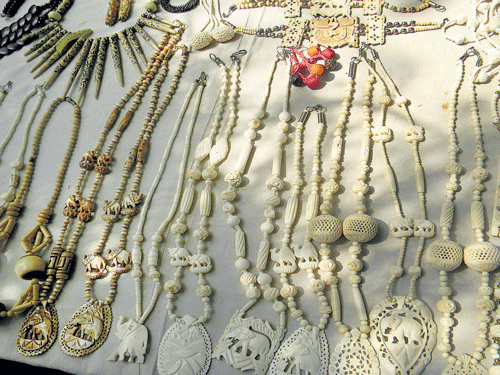
Bone jewellery is an imitation of ivory jewellery, and has been an exquisite craft from the walled city of old Delhi. I recently came across master craftsman Kahkashan from Old Delhi, a 42-year-old woman who represents the fourth generation of a family which has traditionally dealt in jewellery making.
“Traditionally, we used to first carve jewellery out of ivory,” Kahkashan revealed. “But since the ban on ivory some 30 years ago, we now work on sandalwood, buffalo bone and camel bone. We source our camel bones from Rajasthan.” Speaking of the difference between ivory and camel bone jewellery, the former has an off-white tinge, she said.
Ivory assumes an important cultural symbol in many societies across the world. In India, Kahkashan informed, a Gujarati bride is given an ivory bangle as a gift by her family just before the wedding. In Rajasthan too, she said, ivory bangles form an important part of bridal jewellery. “There are many other regions in India where it is compulsory for the bride to wear ivory bangles during the wedding ceremony.” Elsewhere in the world, ivory has also been much sought after not only for jewellery, but also for piano keys. This profuse use had resulted in the incessant killing of elephants for their tusks. A steady decline in the elephant population prompted a worldwide ban on ivory sales in 1989.
“We have been using buffalo and camel bones since the ban,” Kahkashan said as she strung a few beads together around an engraved piece carved out of bone. And then she disclosed in a lighter vein, “There are some people who freak out at the mention of bones and think that we kill animals to procure them! It is quite a Eureka moment for them when we tell them that we use the bones of dead animals.”
Kahkashan has been regularly invited to train students at the National Institute of Design, Ahmadabad as well as art institutes and craft centres around Delhi. She and her husband, who happens to be a cousin and from the same family of craftsmen, are often invited by centres in South Africa. “That’s one country where we have met with a good response,” she said. “My husband goes there to impart training on this craft as well.”
Speaking about the market for bone jewellery, Kahkashan apprised that the demand mostly came from markets in Europe. “They love this type of jewellery, which goes elegantly with their apparel. South Africa also has a good market for bone and beaded jewellery. In India, there is not much demand, although it used to receive great patronage sometime in history under the Mughals. Today, it is mostly high-society women in India who make for a steady clientele.”
I came across Kahkashan at the recently held Design Haat by the Apeejay Institute of Design in New Delhi. She was one among the five noted master craftsmen invited to display their products and share their craft techniques with design students.